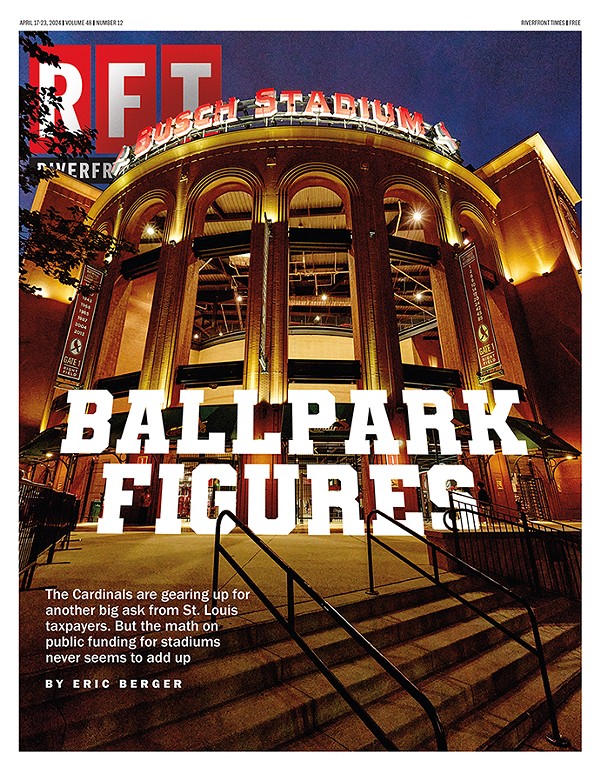Satellite photos identify the Best Mile of St. Louis. Viewed from above, regional development has evolved like an arrow, with its best at its point: the riverfront. Forces greater than our own have placed the length where it is. With the arrival of the Arch and accompanying national park 40 years ago, however, the riverfront was effectively reduced to a quarter-mile stretch of Arch grounds. The rest of the riverbank, sad to say, is a mess: When industry left, they forgot to clean up after themselves, neglected to plant meadows and lay jogging paths. But this year great strides have (finally) been made to reconcile the Lost Mile with the area that surrounds it. In May the Great Rivers Greenway District, in conjunction with a few civic partners, chose Balmori Associates, a New York-based landscape and urban-design firm, to develop plans for future redesign of the riverfront. The mere fact of the Balmori plan is a great first step, but a nice master plan does not a habitable riverfront make. That will take a huge injection of public faith -- and money. The plan is due in May 2006. In the meantime, enjoy the mile: Walk to the center of Eads Bridge, face westward and behold the potential.
Previous Winners
-
2014
The Macklind Avenue Mile
-
2012
Washington Avenue from Vandeventer to Compton avenues
-
2011
Lindell Boulevard from Skinker Boulevard to the Missouri History Museum
-
2010
Ninth Street from Lynch Street to Lafayette Avenue
-
2009
South Grand Boulevard from Shaw Boulevard to Utah Place
-
2008
Cherokee Street
-
2007
Magnolia Avenue from Kingshighway
to Grand Boulevard -
2006
Manchester Avenue from McCausland Avenue to Big Bend Boulevard
-
2004
Market Street, between 4th and 20th streets
-
2004
Market Street, between 4th and 20th streets
Years ago they asked John Danforth why he chose to join the Republican Party. His reply: "For the same reason you sometimes choose which movie to see. [It's] the one with the shortest line." These days our former three-term U.S. Senator and onetime U.N. ambassador is looking for a much better reason to stick with the GOP, short line notwithstanding. In recent months the 69-year-old Danforth has sparked a bit of a political firestorm by calling for his party to eschew any takeover by Christian fundamentalists and instead return to its more moderate roots. "[The Christian right's] problem is they have such a degree of certainty and lack of humility in taking that position that it's accepted as: "Our agenda is God's agenda,'" he told the Riverfront Times last month. But we don't tap a person as "Best Citizen" for displaying a modicum of political courage. Danforth is also working hard to make St. Louis a better city, taking concrete steps to inject civic pride and a sense of life into the languishing Arch grounds -- pledging $150 million from his family's foundation (which he chairs) to do just that. Next movie's on us, Senator.
As the power brokers hammer out details of a master plan for the St. Louis riverfront, one item will doubtless top their to-do list: Find a way to bury I-70 in front of the Gateway Arch. Urban planners and civic boosters have long maintained that the interstate has severed the city from the Mississippi. Today's riverside-bound pedestrian must brave a gauntlet of cars and concrete -- not exactly a setup that draws folks to the waterfront. So why not cap I-70, build pedestrian-friendly retail around the Arch and reconnect the city to one of its past glories? Sure, there'll be a high-stakes wrangle with the federal government, which owns the highway and the Arch grounds. And it won't come cheap (Mayor Francis Slay will say only that "it will cost millions of dollars and take years to complete"). But in the end, the Mississippi is one of this town's greatest assets. It's high time we get to appreciate it.
Viva El Birdos scribe lboros knows so much about Cardinals baseball that he spends most of his columns debating himself. Topics that have taken on great controversy in his own mind (and thus spilled upon the digital page) include: Who's had a better first 600 at-bats, So Taguchi or Willie McGee? (Remember, you've got to consider "the changes to busch stadium between the 1980s and 2000s" and "the difference in run-scoring context between the two eras.") Also, wonders lboros, has shortstop David Eckstein been a net asset to the team or a liability since coming over from the Angels? Sure, his NRAA -- that's Net Runs Above Average -- sucks, but his "Situational Intelligence" is solid. The blog features commentary from other armchair managers and links to other baseball blogs, but in Cardinal Nation, lboros is tops: thought-provoking, thorough and well-written. Viva "Viva"!
Steve Patterson bills his Urban Review-St. Louis as "an urbanist's critique on the City of St. Louis and the St. Louis region." Yeah, everybody's a critic, but Patterson's got cred. He was a design-build designer who became a city real estate agent; he knows the built environment, he knows the neighborhoods. While the rest of us bitch about what developers and regulatory boards do, he actually attends the meetings, contributes his thoughts and opinions. And he always puts his mouth and money together: He ran for alderman of the 25th Ward, and he's a passionate cyclist (use the blog's search engine to piece together The Bike Rack Rants) who became a certified bike-safety instructor. Patterson goes everywhere, investigates everything and imparts important information clearly. He's a pragmatic optimist pushing for St. Louis even when it pushes itself into the ground. We care more when we know more, and Urban Review-St. Louis has our back.
His campaign to fill big Dick Gephardt's Third Congressional District shoes may have been a little lackluster. But since heading to Washington, D.C., Russ Carnahan has proven himself able. With a seat on the Transportation and Infrastructure Committee, Carnahan likes to boast, he brought home the bacon in the form of a $42 million transportation infusion for the region. He also vigorously opposed the Central American Free Trade Agreement, arguing that it will drain Missouri jobs. "Freshman term is really a steep learning curve. You spend a lot of time figuring out how things work, and Carnahan seems to have discovered the levers of congressional power," props Saint Louis University political scientist Steven Puro. "I've been impressed with his performance." But is Puro truly struck by a sterling performance, or is he merely taken with the fact that Carnahan has exceeded the promise of a bland campaign? "No comment," says the professor.
Help Wanted: WGNU (920 AM) seeks radio personality to host weekly show and serve as conservative punching bag during debates with Lizz Brown. Qualified applicants will be well-read, punctual, organized and prepared to discuss local issues including St. Louis Public Schools, the future of downtown and ways to celebrate your birthday other than getting yourself arrested for murder. Drug test required.
It's not easy being LEED: The worldwide designation for "Leadership in Energy and Environmental Design," bestowed on buildings by the U.S. Green Building Council, requires strict adherence to standards addressing everything from how and with what chemicals the inside of the building is cleaned to the level of water reclamation a project has in place. For the greenest of the green, a hierarchy of LEED certification (which culminates in platinum) assigns points for providing natural daylight and outdoor views to workers, reusing an existing building, keeping a cap on the distance from which supplies are collected and offering bicycle storage and changing rooms for commuters. We bet the folks at Alberici Enterprises (and lead architects Mackey Mitchell Associates) were real overachievers in school: When they decided to go LEED with their new headquarters near Page and I-170, they were aiming Platinum. And as of July of this year, not only are they riding high on their Platinum bling, but their headquarters got the nod for the greatest number of points ever awarded to a new-construction LEED project -- 60 out of a possible 69. (The company points out that "the 9 points that would have given Alberici a perfect score were credits that the company elected not to pursue, or were impossible to achieve on the site.") What makes the building so great? Openness and actual fresh air (which flows in when a sensor determines the outside temperature and humidity are acceptable), a state-of-the-art cafeteria and kitchen, covered parking in an existing building that reduces heat-collecting asphalt, recycling stations and, perhaps most visible, a tall white wind turbine that generates power. Company execs say employees feel better, and the work environment has sparked interaction and innovation. The only downside? This is Missouri's only Platinum-certified project.

Forty seasons after its opening, the stadium that was home to Gibby, the Wizard and Prince Albert is perched over history's dustbin. The unique ballpark is revered by baseball fans and architects alike. Redbirds fans love it because, well, it's chock-full of memories. Archophiles adore it for its use of formed concrete and steel, its subtle interplay with the Gateway Arch and its first-class lineage as one of Edward Durrell Stone's modernist masterpieces. Yes, despite its rusting rafters, aging mechanics and crumbling concrete, Busch is beguiling to the bitter end. Thanks for the memories.
This year's cheap thrill was to go to the Discovery Bridge at Highway 370 and the Missouri River, where an optical illusion has prompted at least five people to think they could jump the twelve- to twenty-foot span separating the eastbound and westbound lanes. None has been successful. At least three have died. Always the spoilsport, the Missouri Department of Transportation recently installed lights under the bridge that will, presumably, stop daredevils from thinking they can make the leap. What then is the cheap-thrill seeker to do? How about cast aside the death wish and start investing in your future? At a just a dollar a pop, few thrills come cheaper than the Missouri Lottery. Over the years scads of poor saps have catapulted from the food-stamp class to the country-club set thanks to the lottery. On your way to Luckytown, you might want to fill "er up at the QuikTrip at 8205 Gravois Road. On three separate occasions, this gas station/convenience mart has sold a winning Missouri Lotto jackpot ticket -- most recently in April, when a local couple walked away with $1.3 million.







